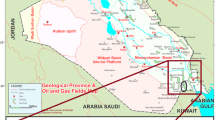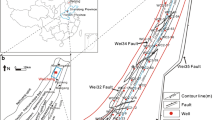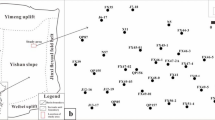Abstract
In the direction perpendicular to a braided river, the continuity of the sand body is sub-optimal, so it is difficult to predict its lateral distribution in the reservoir modelling process. In addition, owing to the differences in well patterns in an oilfield, using the same set of variation functions to establish the sand body distribution model for the whole area is often infeasible, as it cannot reflect the planar heterogeneity of the sand body. In view of these shortcomings of the modelling process, this paper presents a method of sandstone–mudstone facies modelling for braided river reservoirs with irregular well patterns. First, according to the well pattern distribution, the study area is divided into different modelling units to regularize and unify the well pattern of each modelling unit as much as possible. Then, the sandstone–mudstone facies model of each unit is determined by the stochastic modelling method, and the variation function suitable for the unit is obtained. According to the well pattern density within each unit, the corresponding weights are set, and the variation functions of all units are weighted and averaged to derive a set of variation functions suitable for the whole area model. These functions are used to establish the lithofacies model of the Linpan oilfield. Finally, two new methods are adopted to test the accuracy of the model. They both confirm that the model has high stability, the variogram has strong adaptability, and it can effectively predict the distribution proportion of sandstone and mudstone in the unknown area between the wells.


















Similar content being viewed by others
References
Fillion, M.; Hadjigeorgiou, J.: Quantifying influence of drilling additional boreholes on quality of geological model. Can. Geotech. J. 56(3), 347–363 (2018)
Hamdi, M.; Zagrarni, M.; Djamai, N.; Jerbi, H.; Goita, K.; Tarhouni, J.: 3D geological modeling for complex aquifer system conception and groundwater storage assessment: case of Sisseb El Alem Nadhour Saouaf basin, northeastern Tunisia. J. Afr. Earth Sci. 143, 178–186 (2018)
Milicich, S.; Pearson-Grant, S.; Alcaraz, S.; White, P.; Tschritter, C.: 3D geological modelling of the Taupo Volcanic Zone as a foundation for a geothermal reservoir model. NZ J. Geol. Geophys. 61(1), 79–95 (2018)
Sun, Q.; Shao, J.; Wang, Y.; Ma, T.: Research on appropriate borehole density for establishing reliable geological model based on quantitative uncertainty analysis. Arab. J. Geosci. 12(13), 410 (2019)
Yang, J.; Li, W.; Gao, S.; Zhang, J.; Zhang, Y.; Lu, J.: Sedimentology, geological modelling and prediction of the remaining oil distribution in a complicated fault-block reservoir in the Weicheng oilfield, Dongpu Depression, China. Geosci. J. 23(5), 791–804 (2019)
Kempka, T.; Norden, B.; Ivanova, A.; Luth, S.: Revising the static geological reservoir model of the Upper Triassic Stuttgart Formation at the Ketzin pilot site for CO2 storage by integrated inverse modelling. Energies. 10(10), 1559 (2017)
Sebacher, B.; Hanea, R.; Stordal, A.: An adaptive pluri-Gaussian simulation model for geological uncertainty quantification. J. Petrol. Sci. Eng. 158, 494–508 (2017)
Wang, Y.; Pyrcz, M.; Catuneanu, O.; Boisvert, J.: Conditioning 3D object-based models to dense well data. Comput. Geosci. 115, 1–11 (2018)
Afshari, A.; Shadizadeh, S.: Integration of petrophysical and seismic data to construct a reservoir permeability model. Energy Sources 37(7), 679–686 (2015)
Xie, Z.: Application of 3D AVO interpretation technique to lithological reservoir in the Hongze area. Appl. Geophys. 2(3), 168–174 (2005)
Cai, Y.; Zhang, X.; Zhang, X.: Application of seismic data to reservoir modelling of the Chegu 201 block. Pet. Sci. 2(2), 66–70 (2005)
Liu, J.; Xu, M.; Lü, X.; Li, C.: 3D geologic modelling of oolitic-beach carbonate reservoirs based on seismic constraint. China Pet. Explor. 22(3), 64–70 (2017)
Pan, Y.; Wei, G.; Zhao, K.; Li, Y.: Application research of reservoir modelling method based on seismic inversion constraint. J. Chengdu Univ. Technol. 44(5), 529–534 (2017)
Zhang, S.; Shao, L.; Song, J.; Liu, D.; Chen, G.; Ren, C.: Application of facies-controlled modelling technology to the fault-block A11 in A’nan oilfield. Pet. Explor. Dev. 35(3), 355–361 (2008)
Yi, T.; Xie, C.: Modelling of the reservoir petrophysical parameters under the restriction of sedimentary microfacies. Nat. Gas Geosci. 24(4), 821–826 (2013)
Lai, J.; Wang, G.; Luo, G.; Huang, L.; Zhao, X.; Li, H.; Li, M.; Wang, D.: A fine logging interpretation model of permeability confined by petrophysical facies of tight gas sandstone reservoirs. Prog. Geophys. 29(3), 1173–1182 (2014)
Nabway, B.; Kassab, M.: Porosity-reducing and porosity-enhancing diagenetic factors for some carbonate microfacies: a guide for petrophysical facies discrimination. Arab. J. Geosci. 7(11), 4523–4539 (2014)
Liu, L.; Zhang, J.; Wang, R.; Wang, J.; Yu, J.; Sun, Z.; Wang, G.; Guo, J.; Liu, S.; Zhang, P.; Li, C.: Facies architectural analysis and three-dimensional modelling of Wen79 fault block, Wenliu oilfield, Dongpu depression, China. Arab. J. Geosci. 9(18), 714 (2016)
Jahanbakhshi, S.; Pishvaie, M.; Boozarjomehry, R.: Joint estimation of facies boundaries and petrophysical properties in multi-facies channelized reservoirs through ensemble-based Kalman filter and level set parametrization. J. Petrol. Sci. Eng. 167, 752–773 (2018)
Hoffimann, J.; Scheidt, C.; Barfod, A.; Caers, J.: Stochastic simulation by image Quilting of process-based geological models. Comput. Geosci. 106, 18–32 (2017)
Li, Y.; Teng, Q.; He, X.; Ren, C.; Chen, H.; Feng, J.: Dictionary optimization and constraint neighbor embedding-based dictionary mapping for superdimension reconstruction of porous media. Phys. Rev. E 99(6), 062134 (2019)
Chan, S.; Elsheikh, A.: Parametric generation of conditional geological realizations using generative neural networks. Comput. Geosci. 23(5), 925–952 (2019)
Shirangi, M.: Closed-loop field development with multipoint geostatistics and statistical performance assessment. J. Comput. Phys. 390, 249–264 (2019)
Emery, X.; Maleki, M.: Geostatistics in the presence of geological boundaries: application to mineral resources modeling. Ore Geol. Rev. 114, 103124 (2019)
Hao, M.; Wang, D.; Deng, C.; He, Z.; Zhang, J.; Xue, D.; Ling, X.: 3D geological modelling and visualization of above-ground and underground integration-taking the Unicorn Island in Tianfu new area as an example. Earth Sci. Inf. 12(4), 465–474 (2019)
Liu, H.; Chen, S.; Hou, M.; He, L.: Improved inverse distance weighting method application considering spatial autocorrelation in 3D geological modeling. Earth Sci. Inf. 115, 1–11 (2019)
Bhattacharya, S.; Carr, T.: Integrated data-driven 3D shale lithofacies modeling of the Bakken Formation in the Williston basin, North Dakota, United States. J. Petrol. Sci. Eng. 177, 1072–1086 (2019)
Wang, J.; Zhang, J.; Xie, J.; Ding, F.: Initial gas full-component simulation experiment of Ban-876 underground gas storage. J. Nat. Gas Sci. Eng. 18, 131–136 (2014)
AlKawai, W.; Mukerji, T.; Scheirer, A.; Graham, S.: Integrating statistical rock physics and pressure and thermal history modeling to map reservoir lithofacies in the deepwater Gulf of Mexico. Geophysics 83(4), 15–28 (2018)
Kim, K.; Lee, K.; Lee, H.; Rhee, C.; Shin, H.: Lithofacies modelling by multipoint statistics and economic evaluation by NPV volume for the early Cretaceous Wabiskaw Member in Athabasca oilsands area, Canada. Geosci. Front. 9(2), 441–451 (2018)
Feng, W.: Optimization of reasonable injection-production well pattern in complex fault block of Linpan oilfield. J. Xi’an Shiyou Univ. 29(5), 59–61 (2014)
Guo, X.: Petroleum generation and expulsion kinetics: a case study of the Sahejie Formation source rocks from Linnan Sag of Huimin depression. Acta Sedimentol. Sin. 57(20), 6176–6190 (2009)
Wang, X.; Yang, S.; Zhao, Y.; Wang, Y.: Improved pore structure prediction based on MICP with a data mining and machine learning system approach in Mesozoic strata of Gaoqing field, Jiyang depression. J. Petrol. Sci. Eng. 171, 362–393 (2018)
Wang, M.; Liu, Y.; Lu, S.: Classification and oil system of continental shale: Es3L sub-member of Bonan sag, Jiyang depression, Eastern China. Arab. J. Geosci. 9(3), 178 (2016)
Sun, C.; Yao, S.; Li, J.; Liu, B.: Characteristics of pore structure and effectiveness of Shale oil reservoir space in Dongying sag, Jiyang depression, Bohai bay basin. J. Nanosci. Nanotechnol. 17(9), 6781–6790 (2017)
Liu, J.; Song, G.; Hao, X.; Xu, C.; Liu, K.: Characteristics of fault cementation zone and its origin in Linpan oil pool of the Huimin Depression. Earth Sci. 3(1), 310–316 (2011)
Wang, J.: Fault block of Shengli oilfield-case study of fault block oil reservoirs in Linpan oilfield. Pet. Geol. Recovery Effic. 20(3), 89–91 (2013)
Li, Z.; Zhang, X.; Clarke, K.; Liu, G.: An automatic variogram modelling method with high reliability fitness and estimates. Comput. Geosci. 120, 48–59 (2018)
Liu, Y.; Zhang, B.; Dong, Y.; Qu, Z.: The determination of variogram in the presence of horizontal wells-an application to a conglomerate reservoir modelling, East China. J. Pet. Sci. Eng. 173, 512–524 (2019)
Farid, A.; Khalid, P.; Jadoon, K.; Jadoon, K.; Iqbal, M.; Small, J.: An application of variogram modelling for electrical resistivity soundings to characterize depositional system and hydrogeology of Bannu Basin, Pakistan. Geosci. J. 21(5), 819–839 (2017)
Legleiter, C.: A geostatistical framework for quantifying the reach-scale spatial structure of river morphology: 1. Variogram models, related metrics, and relation to channel form. Geomorphology. 205(15), 65–84 (2014)
Ding, F.; Zhang, J.; Xie, J.; Li, C.; Shi, C.; Zhang, P.; Zhang, M.; Tang, M.: Fine description of structure and sedimentary microfacies of Li32 block of Lijin oilfield, Dongying depression, China. Arab. J. Geosci. 7(5), 1693–1704 (2014)
Wang, J.; Zhang, J.; Xie, J.: Analysis of the factors that influence diagenesis in the terminal fan reservoir of Fuyu oil layer in the southern Songliao basin, northeast China. Open Geosci. 10(1), 866–881 (2018)
Acknowledgements
This work was supported by the National Natural Science Foundation of China (Grant Number 51504143; Grant Number 51674156). The authors would like to thank the Sinopec Shengli Oilfield workers for supplying research data. The authors would like to thank Fu Yuxiang and Yan Zhaoxun for the great help in the manuscript revision process.
Author information
Authors and Affiliations
Corresponding author
Rights and permissions
About this article
Cite this article
Jinkai, W., Shaobo, J. & Jun, X. Lithofacies Stochastic Modelling of a Braided River Reservoir: A Case Study of the Linpan Oilfield, Bohaiwan Basin, China. Arab J Sci Eng 45, 4891–4905 (2020). https://doi.org/10.1007/s13369-020-04577-5
Received:
Accepted:
Published:
Issue Date:
DOI: https://doi.org/10.1007/s13369-020-04577-5




